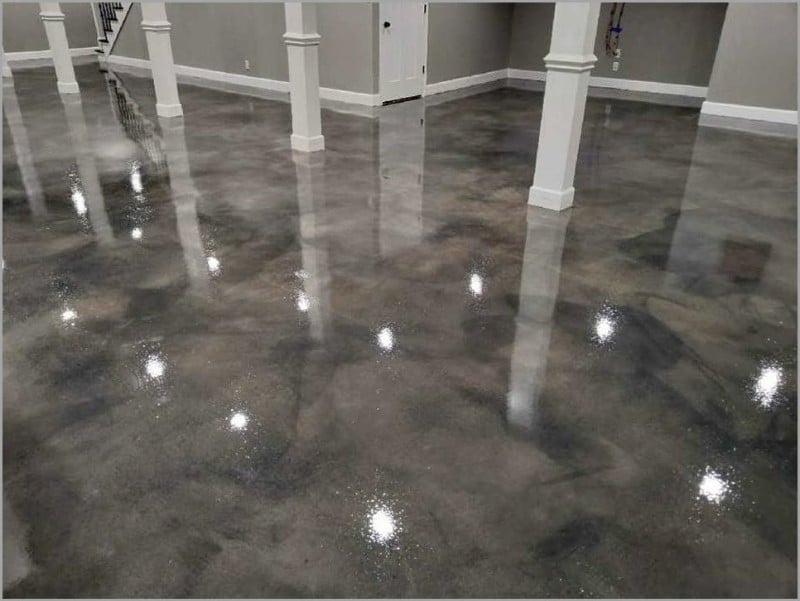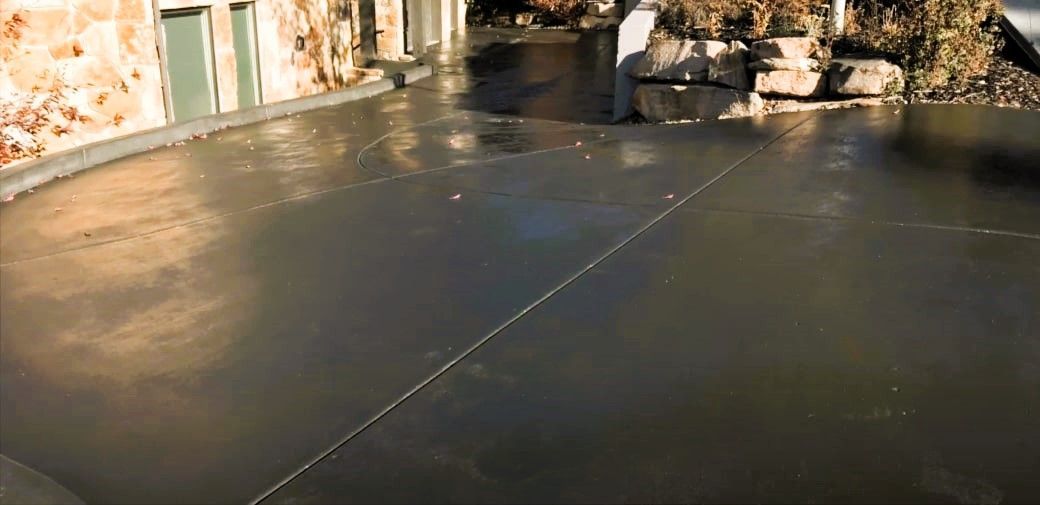The durability of austin stained concrete floors explained
Everything About Stained Concrete: A Comprehensive Guide to Its Advantages and Applications
Stained concrete has arised as a preferred option for both residential and business spaces. Its ability to incorporate aesthetic allure with practicality makes it an intriguing choice. Various discoloration strategies supply a variety of shades and coatings, permitting personalization. Nonetheless, the benefits expand past appearance. Comprehending its applications and maintenance demands is essential for anyone considering this functional product. The subtleties of stained concrete welcome additionally exploration.
What Is Stained Concrete?

Discoloration can be related to numerous surfaces, including floorings, driveways, and outdoor patios, making it a functional option for both indoor and outside rooms. The therapy can accomplish a variety of appearances, from natural tones to vibrant, modern designs. Unlike paint, stained concrete preserves its look gradually, as it comes to be an essential part of the concrete itself. Generally, stained concrete offers as a reliable approach for changing common concrete right into visually striking surfaces.
Benefits of Stained Concrete
Stained concrete offers significant advantages, particularly in aesthetic charm and longevity - Austin Stained Concrete Floors. Its vivid shades and special patterns enhance the visual charm of any type of room, making it a preferred option for both domestic and commercial applications. Furthermore, the longevity of stained concrete warranties that it remains a sensible financial investment over time, withstanding deterioration
Visual Allure
Among one of the most engaging advantages of making use of stained concrete is its impressive visual charm. Stained concrete offers an unique and flexible look that can enhance different design styles, from modern-day to rustic. The infusion of vibrant colors and detailed patterns enables property owners and designers to develop customized surfaces that can improve the general ambiance of a space. Unlike traditional floor covering choices, stained concrete can mimic the look of natural stone or sleek marble, offering a high end look without the associated expenses. Additionally, the glossy surface alternatives can mirror light, further lightening up insides. This flexibility makes stained concrete a favored option for both residential and commercial applications, where visual effect is critical.
Toughness and Longevity
The excellent visual top qualities of stained concrete are complemented by its amazing toughness and long life - Stained Concrete Austin. Stained concrete surfaces are immune to wear and tear, making them appropriate for high-traffic locations both inside your home and outdoors. Their durable nature suggests they can withstand severe weather, consisting of severe temperature levels, rainfall, and UV exposure, without considerable destruction. In enhancement, stained concrete requires minimal maintenance compared to other flooring choices, as it does not require constant sealing or redecorating. This long life not just reduces substitute prices but additionally contributes to a lasting structure strategy. In general, stained concrete supplies a long-lasting option that integrates visual appeal with useful advantages, ensuring its value with time
Different Kinds Of Staining Methods
Different staining strategies can considerably influence the visual high qualities of concrete surfaces. The three key techniques include acid discoloration, which responds chemically with the concrete, water-based staining, which offers a wider variety of colors, and overlay staining choices that supply a fresh surface. Each method has special qualities and applications that accommodate various layout preferences and project demands.
Acid Discoloration Method
How can house owners change simple concrete surfaces into visually striking features? One reliable method is acid discoloration, a popular strategy that enhances the all-natural charm of concrete. This process involves applying a remedy of water, hydrochloric acid, and metallic salts to the concrete surface. As the acid reacts with the lime existing in the concrete, it creates abundant, variegated colors that resemble marble or rock. Acid staining is understood for its resilience and resistance to fading, making it a durable option for both interior and outside applications. It is essential to keep in mind that the results can vary based on the initial concrete color and texture. Appropriate application and securing are important for attaining the preferred visual and longevity
Water-Based Staining Technique
A prominent choice to acid staining, the water-based discoloration technique provides home owners a versatile method to enhance concrete surfaces. This technique uses water-soluble dyes and pigments, enabling a vast array of colors and finishes. Unlike acid discolorations, water-based spots can be related to unsealed concrete and use an easier cleaning process. The outcomes can accomplish a much more uniform appearance and can be layered to develop unique effects. Additionally, water-based stains are typically less toxic and release less volatile organic substances (VOCs), making them extra eco-friendly. Property owners may appreciate the capability to personalize their concrete surfaces with various shades, permitting imaginative expression while maintaining toughness and durability in their floor covering options.
Overlay Staining Options
Countless overlay discoloration alternatives exist for house owners aiming to renew news their concrete surfaces. One popular choice is acid discoloration, which reacts chemically with the concrete to create rich, variegated colors. An additional choice is water-based staining, offering a broader shade combination and much easier application. In addition, concrete overlays can be incorporated with stencils for complex designs, boosting visual appeals. For a much more best site distinctive coating, homeowners might consider using stamped overlays that resemble natural products like stone or ceramic tile. Each method offers one-of-a-kind benefits, from durability to modification, permitting a personalized touch. Eventually, the option of overlay discoloration depends on the wanted appearance and the condition of the existing concrete, ensuring a refreshed and enticing surface.
Applications of Stained Concrete
Stained concrete offers a versatile option for various applications, enhancing both aesthetic appeal and capability. This material is frequently made use of in domestic, commercial, and industrial settings, making it a prominent selection among architects and designers. In homes, stained concrete can work as fashionable flooring or outside patios, providing a sophisticated appearance while continuing to be sturdy.
In business areas, such as retailers and restaurants, stained concrete adds to a modern setting and can stand up to heavy foot website traffic. In addition, stained concrete is progressively used in public areas like parks and pathways, where its capability to resemble natural stone or other products includes visual rate of interest.
Moreover, stained concrete is excellent for swimming pool decks and driveways, using a slip-resistant surface area that is simple to maintain. Generally, the flexibility of stained concrete makes it appropriate for various environments, dealing with varied tastes and needs.
Maintenance and Treatment for Stained Concrete
Correct upkeep ensures the longevity and elegance of stained concrete surface areas. Normal cleaning is essential; making use of a mild detergent and water with a soft-bristle brush assists get rid of dust and gunk without damaging the surface. It is advisable to stay clear of severe chemicals that can strip away the tarnish or sealant.
Securing stained concrete is important for defense versus moisture, spots, and wear. A top quality sealer needs to be reapplied every one to three years, depending on the website traffic and direct exposure the surface area endures. In addition, addressing spills quickly will protect against discoloration and discoloration.

Cost Factors To Consider for Stained Concrete Projects
When preparing a stained concrete job, spending plan factors to consider play a vital duty in identifying the total cost. The expenses related to stained concrete can vary considerably based on numerous aspects. First, the size of the location to be stained straight affects material and labor expenses. Bigger spaces will naturally need more resources. Second, the sort of discolor selected-- acid-based or water-based-- can affect rates, with acid stains often being a lot more costly. Furthermore, the intricacy of the design, including patterns or several colors, can increase labor prices. Preparation work, such as cleansing and grinding the concrete surface area, includes to the preliminary costs. Ultimately, the selection between do it yourself installment and hiring a professional specialist will additionally influence the spending plan. Comprehending these factors enables property owners to make informed financial decisions regarding their stained concrete tasks, guaranteeing they attain the preferred aesthetic within their monetary means.
Tips for Choosing the Right Stained Concrete for Your Space
Picking the ideal stained concrete for a details room entails cautious consideration of various factors beyond simply spending plan. First, one ought to evaluate the intended use the location. High-traffic areas may require even more sturdy surfaces, while decorative applications can prioritize looks.
The color palette is another essential element; the picked tones should balance with existing design and lighting. It's also crucial to think about the surface appearance, as smooth coatings can boost class, while textured alternatives might ensure safety in damp areas.
Regional environment and ecological conditions play a significant role in the long life and maintenance of stained concrete, influencing the selection of sealers and finishes.
Lastly, consulting with experts can give valuable insights tailored to certain requirements, ensuring the selection of the perfect stained concrete that straightens with both performance and design.

Regularly Asked Questions
Can Stained Concrete Be Applied Over Existing Floor Covering?
Stained concrete can indeed be used over existing flooring, provided the surface area is stable and sufficiently prepared. This method permits for an aesthetic upgrade without the requirement for total removal of the original floor covering materials.
For How Long Does Stained Concrete Last?
Stained concrete can last for decades when appropriately maintained. Variables such as traffic, ecological conditions, and application methods significantly influence its longevity, with many installations staying dynamic and intact for 10 to 30 years.
Is Stained Concrete Slippery When Wet?
Stained concrete can be unsafe when wet, as the surface might produce a smooth surface. Using non-slip ingredients or distinctive coatings can reduce this concern, enhancing security without compromising the aesthetic charm of the concrete.
Can I Tarnish Concrete Myself, or Should I Hire an Expert?
The choice to tarnish concrete directly or hire a professional depend upon skill level and job complexity. While do it yourself staining can conserve cash, specialists assure excellent outcomes, especially for elaborate styles or big surfaces.
What Colors Are Offered for Stained Concrete?
The range of colors offered for stained concrete consists of natural tones like browns and tans, vibrant tones such as reds and blues, and softer hues like pastels. This scheme allows for imaginative, individualized style choices.